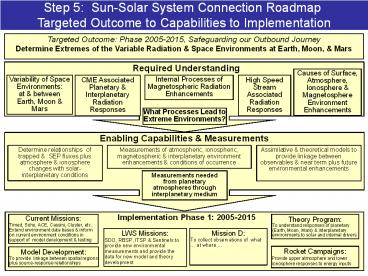Targeted Outcome: Phase 20052015, Safeguarding our Outbound Journey - PowerPoint PPT Presentation
Title:
Targeted Outcome: Phase 20052015, Safeguarding our Outbound Journey
Description:
Determine Extremes of the Variable Radiation & Space Environments at Earth, Moon, & Mars ... Rocket Campaigns: Provide upper atmosphere and lower ionosphere ... – PowerPoint PPT presentation
Number of Views:36
Avg rating:3.0/5.0
Title: Targeted Outcome: Phase 20052015, Safeguarding our Outbound Journey
1
Step 5 Sun-Solar System Connection Roadmap
Targeted Outcome to Capabilities to
Implementation
Targeted Outcome Phase 2005-2015, Safeguarding
our Outbound Journey Determine Extremes of the
Variable Radiation Space Environments at Earth,
Moon, Mars
Required Understanding
Causes of Surface, Atmosphere, Ionosphere
Magnetosphere Environment Enhancements
Variability of Space Environments at between
Earth, Moon Mars
CME Associated Planetary Interplanetary
Radiation Responses
High Speed Stream Associated Radiation Responses
Internal Processes of Magnetospheric Radiation
Enhancements
What Processes Lead to Extreme Environments?
Enabling Capabilities Measurements
Measurements of atmospheric, ionospheric,
magnetospheric interplanetary environment
enhancements conditions of occurrence
Determine relationships of trapped SEP fluxes
plus atmosphere ionosphere changes with
solar-interplanetary conditions
Assimilative theoretical models to provide
linkage between observables near term plus
future environmental enhancements
Measurements needed from planetary atmospheres
through interplanetary medium
Implementation Phase 1 2005-2015
Current Missions Timed, Soho, ACE, Cassini,
Cluster, etc. Extend environment data bases
inform on current environment conditions in
support of model development testing
Theory Program To understand responses of
planetary (Earth, Moon, Mars) interplanetary
environments to solar and internal drivers
LWS Missions SDO, RBSP, ITSP Sentinels to
provide new environmental measurements and
provide the data for new model and theory
development
Mission D To collect observations of what at
where
Rocket Campaigns Provide upper atmosphere and
lower ionosphere responses to energy inputs
Model Development To provide linkage between
spatial regions plus source-response relationships
2
SAFEGUARD OUTBOUND JOURNEYEnvironment Issues
Associated with Earth to Moon Traversal
Transport from Earth to Moon Preparation of crew
transport vehicle in Earth orbit? Yes Then bring
crew to vehicle and prep at LEO (Low Earth
Orbit) No Launch from ground to LEO as initial
step with transfer burns following Transport from
LEO through magnetosphere to cislunar space Lunar
orbit capture Transport from Lunar orbit to
surface Whole ship or lander only? Determines
different environment requirements - surface only
or surface plus orbiting unit Liftoff from
surface Transport from cislunar space to low
Earth orbit through magnetosphere All the way to
Earth surface? No Leave crew transport vehicle
in LEO and use reusable launch vehicle to
descend to Earth? Yes Descend in transport
vehicle to surface
3
SAFEGUARD OUTBOUND JOURNEY (Cont.)Environment
Issues Associated with Earth to Moon Traversal
- Space environment hazards of LEO crew transport
assembly and preparation - Radiation effects on assembly workers and crew
- Cosmic rays and high energy SEPs
- LEO edge of inner zone protons and electrons (for
EVA) - Communications effects of ionosphere
- Atmospheric drag and Atomic Oxygen issues
- EVAs
- Yes Vehicle/Astronaut charging and radiation
dose as hazards - No (no EVA) Launch from ground to LEO (Low Earth
Orbit) as initial step - Transport from LEO through magnetosphere
radiation belts to cislunar space with
occassional moderate energy bursts in plasma
sheet plus SEP exposure - Lunar orbit capture communication issues and
radiation exposure - Transport from Lunar orbit to surface
communication issues and radiation exposure - Surface dwelling
- Radiation exposure, communications issues,
contamination by dust and charged dust
4
SAFEGUARD OUTBOUND JOURNEY (Cont.)
- Liftoff from surface
- Communication issues
- Transport from cislunar space to low Earth orbit
through magnetosphere - Same as outbound trip
- All the way to Earth surface?
- No Extended radiation and SEP esposure while at
LEO - Yes Communications and atmospheric variability
issues































